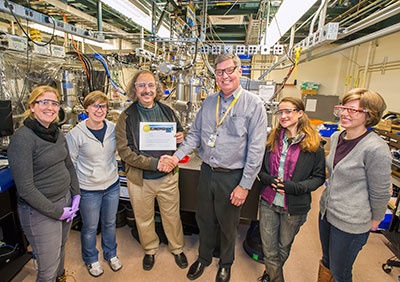In the Chemical Sciences Division (CSD) we encourage everyone to help find controls to the safety hazards facing them. Who better knows their work environments?
By engaging the many post-docs, students, PIs, and support staff to work in partnership with resources like division safety coordinators and EHSS, we aim to empower individuals who make collaborative, proactive decisions on how to perform their work safely.
Since I became Interim Director last May, I’ve seen efforts that have made our Division not only a safer place to work, but also a more productive one. I credit these successes to team-based solutions.
Last year Thorsten Weber, a staff scientist in the Division, needed help with unconventional ergonomic-related risks in his Lab. Years ago Thorsten had strained his back while in the lab and wanted to prevent that from happening to colleagues. I asked Thorsten to reach out to EHSS and he teamed with ergonomist Melanie Alexandre. The two helped create a set of solutions that addressed all of his major concerns regarding lifting, reaching, and prolonged standing. Yes, this cost money and Thorsten’s time away from research. However, we now know these Lab workers have the needed tools to complete their jobs efficiently and safely. It pays not to cut corners.
Sometimes the tools are in place but it’s the correct process that can be overlooked. Recently a grad student in one of our labs bruised her hand after her wrench slipped. I had familiarity with the types of vacuum chambers she was working on so I visited the lab and met with the students involved. I shared how I had learned to work with these awkwardly shaped chambers and made the situation casual, without a PI or anyone else present. Sharing safety knowledge this way is a win-win situation because we learn how to safely perform specific functions that relate to us while becoming more productive in the process.
That visit illustrated several fundamental tenets of our safety culture: building trust, looking out for each other, and providing on-the-job training. These are especially important for us since we host many post-docs and grad students.
| Ali Belkacem, second from left, receives a Safety Spot Award from EHSS Acting Director Joe Dionne for his visit to a laser lab, where he shared some tips on preventing accidents when working on vacuum chambers. Other grad students with him from left, Birgitta Bernhardt, Erika Warrick, Justine Bell, and Annelise Beck. |
But building trust takes time. One way to do that is by using our Division Safety Coordinators, Jerry Bucher and Martin Neitzel. They help solve problems on a daily basis. Additionally, they strengthen relationships throughout the Division by attending group meetings and partnering with EHSS to involve lab staff, which creates a proactive trickle-up approach to safety.
The overriding idea is to partner with and engage everybody involved on projects in a cooperative, positive way. Some specific tasks in our labs require the equivalent of a mini-JHA, where extra precautions and processes need to be established. In those cases, we enlist the division safety coordinator, experimenter, PI, and any other involved parties to propose a solution. Management doesn’t dictate how to resolve a safety problem, but encourages those who know best to come up with the solution.
Safety truly is a proactive process. And it definitely is something that benefits from a group consensus. When management shows it cares and takes the time to talk to all parties on the subject, a community of trust enables an efficient, conscious work environment.

